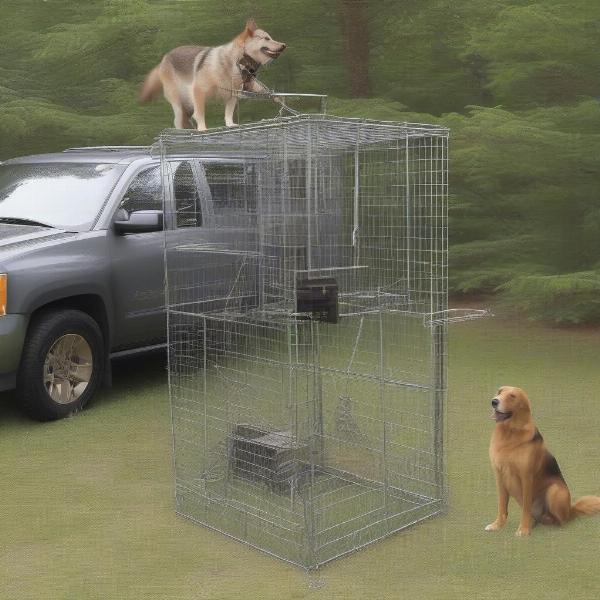Dog proof coon traps are a crucial consideration for dog owners, especially those living in rural areas or regions where raccoons are prevalent. These traps are designed to minimize the risk of accidental capture and injury to your dog while effectively targeting raccoons. Understanding how these traps work, their benefits, and how to use them responsibly is essential for protecting your furry friend and managing raccoon populations safely.
What Makes a Coon Trap “Dog Proof”?
Dog proof coon traps incorporate specific design features to deter dogs from entering and triggering them. These features often include smaller trap openings, trigger mechanisms placed further inside the trap, and sometimes a cage-like structure. These modifications make it difficult for a dog’s larger paw or snout to reach the trigger, reducing the likelihood of accidental capture. Some traps also use bait that is less attractive to dogs, such as marshmallows or sweet corn, while still appealing to raccoons. Choosing a truly dog-proof trap is essential, as a standard raccoon trap can pose a significant danger to your dog.
Why Choose Dog Proof Raccoon Traps?
Beyond the obvious benefit of protecting your dog, dog scale dog-proof coon traps offer several advantages. They provide a humane way to manage raccoon populations, minimizing the risk of injury to both the raccoons and other non-target animals. These traps allow for the safe relocation of captured raccoons, helping to prevent conflicts without resorting to lethal methods. Using these specialized traps also promotes responsible wildlife management, ensuring a balanced ecosystem.
Setting Up Dog Proof Coon Traps Safely
 Setting Dog Proof Coon Traps Safely
Setting Dog Proof Coon Traps Safely
Placing your dog-proof traps strategically is key to their effectiveness and your dog’s safety. Select locations that are frequented by raccoons, such as near garbage cans, compost bins, or fruit trees. Crucially, position the traps away from areas your dog can access, such as fenced yards or commonly used paths. Securing the trap to a stable object will prevent it from being dragged away by a captured raccoon, further minimizing the risk to your dog.
What to Do if Your Dog is Caught in a Trap
While dog-proof traps are designed to prevent captures, accidents can still happen. If your dog becomes trapped, remain calm and approach cautiously. Speak to your dog in a soothing voice to keep them calm. If possible, cover the trap with a blanket or towel to reduce stress. Contact animal control or a wildlife rehabilitator immediately for assistance in safely releasing your dog. This experience underscores the importance of using only genuinely dog-proof traps and placing them carefully.
Maintaining Your Dog Proof Traps
Regular maintenance is essential to ensure the effectiveness and longevity of your traps. Clean the traps after each use to remove any debris or scent that might deter raccoons. Inspect the traps regularly for damage or wear and tear. Replace any broken or worn parts immediately to ensure the trap functions properly and remains safe for non-target animals. Store your traps in a secure location when not in use, away from children and pets.
Conclusion
Protecting your canine companion is paramount, and choosing dog-proof coon traps plays a vital role in responsible raccoon management. These specialized traps offer a humane and effective solution for dealing with raccoon issues while minimizing the risk to your dog and other non-target animals. By understanding how these traps work, setting them up strategically, and maintaining them properly, you can contribute to a safer environment for both your pets and the local wildlife. Remember to always prioritize your dog’s safety and choose truly dog-proof traps to prevent accidental captures.
FAQ
- Are dog-proof coon traps 100% effective in preventing dog captures? While these traps significantly reduce the risk, no trap is completely foolproof. Careful placement and genuine dog-proof design are crucial.
- What bait should I use in a dog-proof coon trap? Marshmallows, sweet corn, or specially formulated raccoon bait are good choices that are less attractive to dogs.
- Where can I purchase dog-proof coon traps? They are available at many hunting and trapping supply stores, as well as online retailers.
- What should I do with a captured raccoon? Contact your local animal control or a wildlife rehabilitator for guidance on safe relocation.
- How often should I check my coon traps? Check your traps daily to minimize stress on any captured animals.
- Is it legal to trap raccoons in my area? Check local regulations and obtain any necessary permits before trapping raccoons.
- What are some alternatives to trapping raccoons? Exclusion methods, such as securing garbage cans and sealing entry points to your home, can deter raccoons.
ILM Dog is your trusted international resource for dog care and wellbeing. We offer expert advice on dog breeds, health, training, nutrition, grooming, and more. From puppy care to senior dog support, we provide practical, reliable information to dog lovers worldwide. For professional guidance on any aspect of dog ownership, contact us at [email protected] or +44 20-3965-8624. ILM Dog is committed to providing accurate, comprehensive, and up-to-date information to support your dog’s health and happiness.